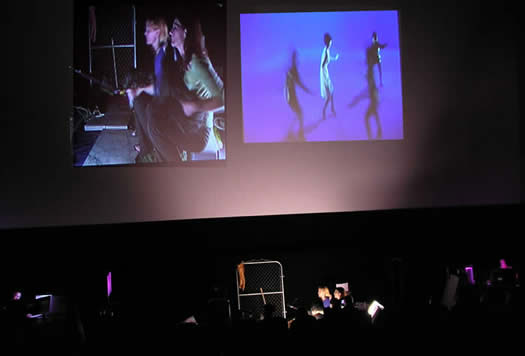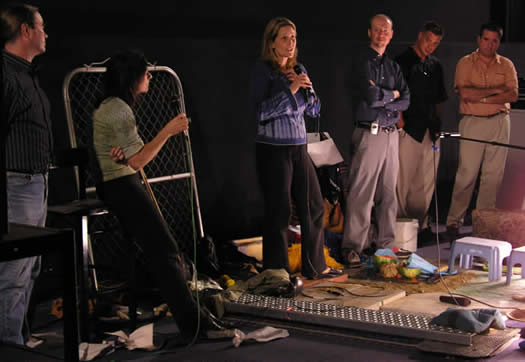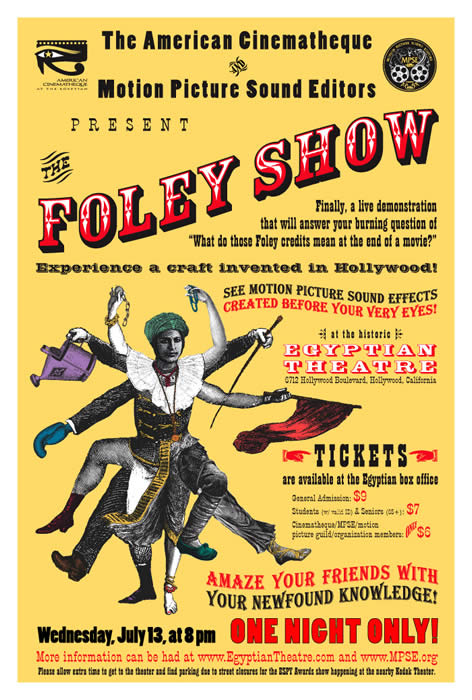The Foley Show

Photos by Frank Morrone, MPSE
Thanks!
This presentation was made possible by Absolute Post Rentals & Rooms, Danetracks, The Dodge College of Film and Media Arts at Chapman University, Paramount Pictures, The Paramount Sound Department, Vitagraph Films, Wexler Video, Foley mixer Randy Singer, Videographer Annie Wildmoser, Technologist Brian Slack, Graphic Designer Melissa Hagan, The Staff of the American Cinematheque, the Board of Directors of the MPSE, and our Foley crew.
Our Foley Crew

Jeremy Pitts, Sarah Monat, Robin Harlan, Scott G.G. Haller, Thomas W. Small and Scott Curtis
Scott Curtis, MPSE - Foley Editor
Scott was born in Kansas City, Kansas, and moved to California when he was 8 years old. After graduating from San Francisco State University he immediately moved to Los Angeles. Scott got into the industry as a receptionist, which lead to being a Machine Room Loader, then a Projectionist, followed by Foley Recordist and finally a Foley Mixer/ Supervisor/Editor for two animated television shows. He then moved to editing Foley on features and currently works as a Supervising Foley Editor.
Scott has made his professional home at Paramount Pictures for nearly 10 years, and from time to time has worked for most of the other studios. His work has received many nominations for the MPSE Golden Reels, and won one in 1998 for the movie Titanic. "Although the job at times can be monotonous and myopic, I gather inspiration from the wonderful Sound Supervisors, Foley Artists, Editors and Mixers I collaborate with."
When not working, Scott relaxes with his patient and supportive wife Maggie and their two children Alex & Katie. He sometimes get to steal away ("There's a hole in the schedule") to play some golf or work on building furniture in his woodshop/garage.
Robin Harlan, MPSE - Foley Artist
A native of Los Angeles, Robin has been working in the film business for over twenty years. Robin first encountered the art of Foley while performing ADR on a film she acted in. She became fascinated with the craft and soon found an apprenticeship with the world-renowned Foley artist John Roesch (pronounced "Rush"). After a two-year residence at TAJ Soundworks, Robin began freelancing and was able to work on top features such as Predator, Die Hard, and Driving Miss Daisy. Following those jobs, she teamed up with her current partner Sarah Monat and the two of them have worked on well over 200 titles, including Face/Off, Mission: Impossible II, Titanic, and Lemony Snicket's a Series of Unfortunate Events. Robin and Sarah have been part of the Feature Foley Crew for Paramount Pictures since 1997. One of the highlights of her career has been performing live sound effects on stage with Leonard Nimoy and John de Lancie of Alien Voices fame.
Robin recently moved to a small ranch in Chatsworth where she lives with her husband, artist Dave Zaboski, and their beautiful daughter Grace.
Sarah Monat, MPSE - Foley Artist
Sarah was born in Vancouver, Canada, and raised and educated in England and South Africa. At the time, her parents were both producers for radio drama and she started developing her Foley skills by creating sound effects for a wide range of radio plays. She came to live in California in the early eighties and has built a major career as a Foley artist. Today Sarah and her partner, Robin Harlan, run the feature Foley stage at Paramount Pictures. She has worked on a vast range of more than 100 major motion pictures including Top Gun, The Color Purple, Titanic, Face/Off, Star Trek: Nemesis & Mission Impossible II and has just completed Bad News Bears and Four Brothers.
Sarah lives in the Silver Lake area and enjoys spending her all too limited leisure time with her husband and two children.
Jeremy Pitts, MPSE - Foley Mixer
Jeremy was raised in Medford, Oregon, surrounded by family. "We all grew up camping and fishing and loving the outdoors. I was very active in the Boy Scouts and had paper route and then was a box boy at the local Quality Market. They STILL won't give me their steak marinade recipe!"
After school Jeremy got involved in his friend's band hauling guitars and eventually mixing the sound. This seemed like a direction to go. He saved his money and moved to Los Angeles to attend a (now defunct) recording school. After making a lot of cappuccino and restaurant runs for recording artists in a Santa Monica studio, the owner burst in asking: "Do you want to be my assistant doing sound for movies?" Six months and six Roger Corman films later he was on his way. To Europe. Since then Jeremy has spent the last 12 years doing many projects, mostly recording and editing Foley FX for hundreds of cartoons, including Duckman, Invader Zim, Clifford the Big Red Dog, and Rugrats. The last two years he's "had the privilege of working with this great crew at Paramount as a Foley editor and things have never been better."
Away from the studios Jeremy still tries to fish and camp and hang out with a few musicians. And there's always the ever present Frisbee with his border collie, Lulubelle.
Thomas W. Small, MPSE - Supervising Foley Editor
Tom was born in Bethesda, Maryland, and grew up just outside of Washington, D.C., then North Carolina, and finally New York before moving to California in 1982. He attended California State University at Northridge, majoring in Film Production. He began his career working on Moonlighting for Dimension Sound. He has been at Paramount since 1991 where he transitioned from Assistant to Editor. He has Supervised the Foley for over 30 films including Face/Off, Mission Impossible II, Sleepy Hollow, Lara Croft: Tomb Raider, Team America, Coach Carter, and Titanic, for which he won the MPSE Golden Reel Award.
In his spare time, Tom enjoys painting, photography, and expanding his knowledge of alternative health therapies.
Scott G.G. Haller, MPSE - Producer & Host
Raised in the Cornhusker State, Scott Geoffrey George Haller is a graduate of Amherst College and the University of Southern California School of Cinema-Television. Scott's initial major sound job was as Paramount Pictures' first feature digital sound assistant. After a number of years he moved on to being a Dialogue, Foley and FX editor and has worked on many movies, including Independence Day, Star Trek: First Contact, Beavis and Butt-Head Do America, Muppets from Space, There's Something About Mary, Tortilla Soup, and The Passion of the Christ. Scott has lectured and published articles on the importance of filmmakers making every effort to get good production sound and produced the MPSE/American Cinematheque sound design show in 2004.
When not massaging audio, Scott has been known to swing dance and catch as many movies as he can.
Jack Foley, MPSE - The Man Who Started It All
Foley, or "Direct-to-Picture," sound effects were first developed by Jack Foley on Stage 10 of the Universal lot (just over the Hollywood Hills from the Egyptian) for the 1929 production of Show Boat. The movie was originally a silent adaptation of the book that had gone on to become a successful Broadway musical. Following the success of The Jazz Singer, the studio decided that this silent movie had to become a soundie. Some scenes were reshot with synchronized sound and a special sound prologue tacked on, but mostly sound was added to the original footage. Not just dialogue and music, but sound effects as well. For that part of the audio track, Jack Foley and his team "performed" a variety of sound effects while watching the projected film during the orchestra's recording session.
Jack Donovan Foley was born in Yorkville, N.Y. in 1891, to Irish immigrant parents. His first job was as a general order clerk on the New York docks. Jack also played a lot of semi-pro baseball in the New York area. Dissatisfied with the weather, Jack moved to California. His first job in the developing movie industry was as a double and stunt man. He went on to be a location scout then screenwriter and director.
After this unique career opportunity appeared in 1929, Jack soon had his own specialized recording studio and worked full time recreating the footsteps and other sound effects of movie performers.
"During Jack Foley's forty-year career at Universal, he became the footstep performer of choice for movie stars on a regular basis, each of which had individual characteristics. Jack referred to Rock Hudson's footsteps as 'deliberate,' James Cagney's were 'clipped,' Audie Murphy's were 'springy,' Marlon Brando's were 'soft,' and John Saxon's were 'nervous.'"*
"Women are the toughest to imitate," he confided, "my 250 pounds may have something to do with it, but the important thing is their steps are quicker and closer together. I get winded doing leading ladies. Jean Simmons is almost, not quite, the fastest on her screen feet in all of Hollywood. She's topped only by June Allyson. I can't keep up with her at all."**
After decades of informal acknowledgement of his "paternity," his name was officially linked to the process when Desi Arnez & Lucille Ball's production company Desilu built their own "direct-to-picture" sound stage and named it the "Foley Stage." (That property is now part of the Paramount lot on Melrose Avenue.)
In 1962 Jack Donovan Foley was awarded an honorary membership from the Motion Picture Sound Editors. In 1997 the MPSE posthumously further recognized his contribution to motion picture sound with a Lifetime Achievement Award.
*From "Practical Art of Motion Picture Sound" by David Yewdall, MPSE
** From http://www.marblehead.net/foley/jack.html by Philip Rodrigues Singer, MPSE

![Text Box: Tonight's Clips: Mission: Impossible (1996), courtesy of Paramount Pictures Foley Artists: Dennie Thorpe & Tom Barwick Foley Mixer: Tony Eckert Foley Editors: Matthew Wood & Marian Wilde Black Tight Killers [Ore ni sawaru to abunaize] (1966), courtesy of Vitagraph Films Original Foley Crew: Unknown](../images/foley_show/clip_clip_image001.gif)
If you enjoyed this show on Foley sound effects and would like to see more,
please send any comments and suggestions to [email protected].
Let us know if there are any movies you would like to see presented for their sound.
We could also look at music, sound effects, dialogue and ADR editing.

